Elastic floating subterranean lines are designed for hydrotransportation of soil during dredging, underwater trenching, hydro-washing of industrial sites, etc. Primer lines are manufactured in several modifications: pressure, pressure-suction and suction.
Authors:

Chizhov A.E.
Director of LLC "Rassvet"

Chizhov A.E.
Ph.D., professor
Deputy. Director of LLC "Rassvet"

Novikov S.G.
Candidate of technical sciences,
associate professor RSSU
Flexible floating groundways are designed for hydrotransportation of soil during dredging, underwater trenching, hydro-washing of industrial sites, etc.
Grounding lines are made in several modifications: pressure, pressure-suction and suction (pic. 1).
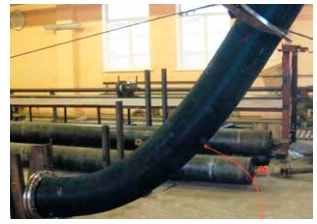
Pic. 1. Suction dredge with a diameter of 325 mm.
According to the geometric form, they are divided into cylindrical and flat-folded, short-length - up to 10 m in length, and long-length - up to 50 m and more in length, up to 920 mm in diameter.
According to the design of the end sections, the subsoil is produced with soft cuffs, stationary rubber-metal flanges and rotating steel flanges on a rubber-fabric "collar" with metal insert elements. The last two connections do not need any additional gaskets (pic. 2).
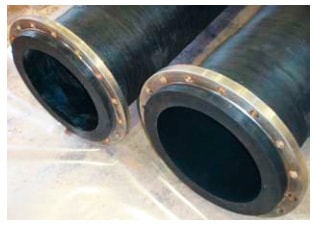
Pic.2. Rotating flanges.
In the design of flange connections, lugs can be provided for passing and fixing the cable from the stern winch and pulling the disconnected section to the dredger. If necessary, floating ground pipes are made with limiters of the angle of rotation of the sections relative to each other.
The stops restrict the angle of rotation of the sections to 400 and are installed on each flange connection of the pipes. At present, together with the specialists of the NDRHS (Nizhne-Don region of hydraulic engineering structures) at the company Rassvet-K" developed a quick-disconnect connection and devices for rallying floating pipelines after their disconnection for the purpose of further transportation. If necessary, the floating earthworks of the "Rassvet-K" production are equipped with special platforms with remote floats - for laying the power cable and installing signal lights (pic. 3).
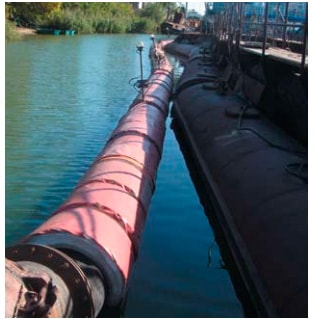
Pic. 3. Two floating earthwork with a diameter of 530 mm.
Floating elastic soil pipes can be completed with intermediate pneumatic pontoons with carrying capacity up to 10 tons, made of composite materials. Lifting capacity and completion of intermediate pontoons in agreement with the customer can be changed.
In the waters of the Arctic seas, having a complex ice situation and a constant wave-wind impact, floating subterranean trains capable of operating in a flooded state are of some interest. A floating underwater pipeline, buried below the water level, is suspended by elastic shock absorbers to the bottom bases of vertical, for example pneumatic, floats.
The elastic shock absorbers are hingedly connected to a flexible coupling fixed on the head and end pontoons of the dredge, which makes it possible to regulate the length of the flexible connection. Cylindrical floats have weighting agents in their lower part, which ensures their vertical position.
On the upper base of the floats are installed areas with signal lights (patent for invention No. 2355849 belongs to the company "Rassvet-K").
Elastic floaters are effective in the simultaneous operation of the following factors: wave height up to 1.5 meters; wind speed up to 10-15 m / s; flow velocity up to 2 m / s; ambient temperature in accordance with GOST 24389-89. Structural materials of the underwater pipelines provide dredging of dredgers with a ground wire at a temperature of up to -400 ° C.
When making ground pipes, materials with uncontrolled properties are not used. Materials are not a nutrient medium for microorganisms and fungi.
They withstand the direct effect of atmospheric factors during the warranty period of operation, are resistant to abrasion and cracking with multiple alternating deformations.
The material of the ground pipes and floats provides corrosion resistance in fresh and sea water. Resistance to hydroabrasive wear or abrasion during hydrotransportation of soils of the 3rd category is 3-4 times higher than that of steel pipes, under the same conditions and is no more than 120-130 mm3 according to Din 53516 or GOST 23509-79.
Pressure mains are made for operating pressure up to 2.0 mPa, as agreed with the customer - up to 4.0 mPa. Guaranteed buoyancy of the ground pipes at a slurry concentration of up to 50%. With full clogging of the groundwork, 5% remains buoyancy.
Guaranteed shelf life and operation of elastic undercuts for at least three years, including at least two navigation operations. The design of floating underground pipelines provides for the rapid replacement of individual elements of sections in case of emergency failure of them. It is possible to carry out repair work under operating conditions.
All the elements of the floating pits are maximally unified and interchangeable. The use of floating flexible subsoil allows reducing the number of re-laying of coastal ground-lines.
When working the suction dredge on shore dumps, we recommend that they be completed with flexible long-dimensioned flat-folded soil pipes with flanges and devices for their transportation, installation and dismantling to and from the shore using the end pontoon winches.
The diameter of flexible flat ground pipes in working order can be up to 1200 mm, length up to 100 meters, are designed for working pressure up to 1.0 mPa. Flexible flattened ground pipes are of low mass: one meter of a flat pipe with a diameter of 320 mm weighs no more than 4 kg. With diameters of more than 1200 mm, flat tubes are transferred to the category of flexible shells.
This feature of flexible flat-folded soil lines, like elasticity, allows them to be wound on a drum. In pic. 4 shows a flat u1075 dredge with a diameter of 219 mm, 30 meters long, wound on a drum 800 mm in diameter.
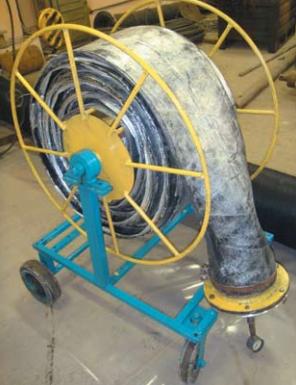
Pic. 4. A flat ground line with a diameter of 219, a length of 30 m, wound on a drum.
The layout of the flat ground from the coil to the shore is carried out with the help of a winch of the end pontoon and a canis-block installed on the shore (pic. 5).
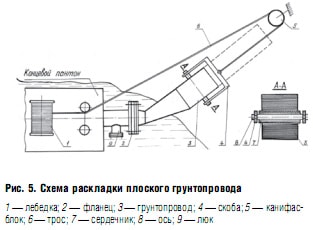
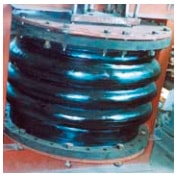
Pic. 6. Radial Compensator.
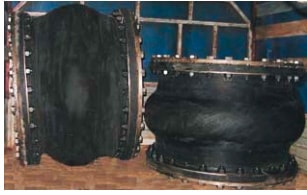
Pic. 7. Companion toroidal.
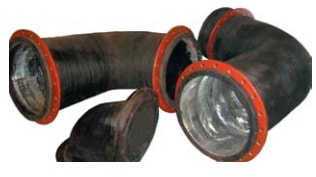
Pic. 8. Taps curved.
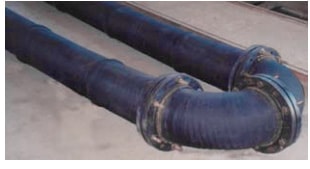
Pic. 9. Elements of hull primer.
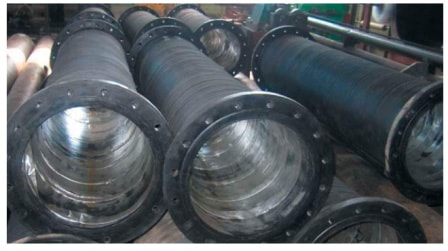
Pic. 10. Elements of hull primer.
The installation of a flat pipeline on the shore or at the site of the proposed work can be carried out using vehicles. The coil with a flat pipeline is mounted cantilever on the tractor. The initial end of the flat pipe is connected to the pumping unit, and the pipeline is practically ready for operation. The mounting time is determined by the speed of the vehicle.
A flat-drained ground can be used as a floating one. For these purposes, three flat-folded pipes are connected with each other by elastic bands. The two extreme flat tubes are pumped with air, they act as floats. Medium ground pipe. All pipes are interchangeable. When the ground pipe is worn, it occupies the place of the float. Long-length flat-folded pipelines can be successfully used as primary casings when working on shore dumps.
In the case of mechanical damage to a flat pipe, repairs in the field are carried out as follows. From the end of the flat pipeline cut off the site (for example, 1 meter), which serves as a coupling. The damaged area is degreased, greased with adhesive composition. On the damaged site, the coupling is pulled, the load is placed on the damage site and maintained for the required time. It is possible to repair with the help of an ordinary car vulcanizer using the same technology as repairing car cameras.
A pressure floating pipe with pneumatic floats and a method of manufacturing thereof are registered as an invention to which patent No. 2358178 has been obtained. For this invention, Rassvet-K "in 2009 was awarded a diploma of the Federal Service for the Protection of Intellectual Property, Patents and Trademarks in the nomination" 100 Best Inventions of Russia ".
Flexibility of floating ground pipes allows using them in conditions of cramped channels, to move the dredge along the slots without ball joints. To connect steel pipelines, we recommend using our flexible elastic inserts. Due to the design features, the flexible joints are able to compensate for significant axial and angular deformations, to damp hydro-impacts, to prevent the development of electrochemical corrosion. One compensator with a diameter of 900 mm, length 800 mm is able to compensate up to 90 mm axial strain. Areas of application: they are used instead of metal ball joints on dredges, as elastic compensators for axial and angular deformations of pipeline systems. Flexible connections - compensators, are made of two types: with radial corrugations (pic.6) and toroidal corrugations (pic. 7).
To increase the service life of the suction dredge for hydroabrasive wear, the hull, as well as the floating one, is made of elastic abrasion-resistant materials. The company "Rassvet-K" produces steeply bent (ℓ = 900) bends (pic. 8).
Taps, most susceptible to hydroabrasive wear, have local hardening. The internal diameter of the flexible bends corresponds to the diameter of the pressure pipes. According to the drawings or technological schemes of the customer, our enterprise manufactures technological lines of pipelines (pic. 9, pic. 10), conducts their preliminary assembly in their own company and in the presence of the customer performs hydrostatic tests.
LLC "Rassvet-K" offers our partners high-quality and technological products. We hope for fruitful cooperation in the field of development and introduction of new products in hydromechanization.


